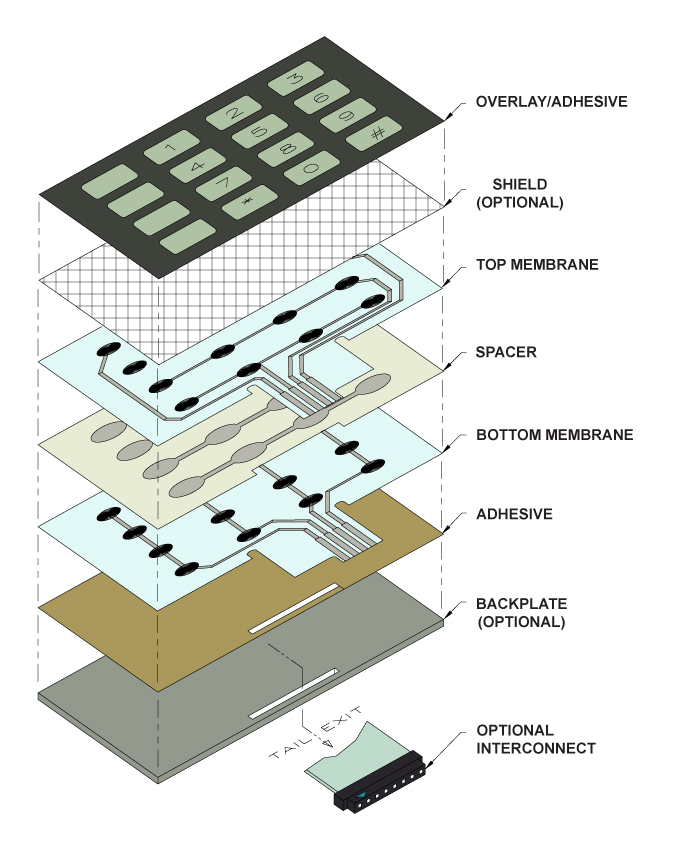Exploring the Advantages of Membrane Layer Changes for Modern Electronics
The expedition of membrane buttons in contemporary electronic gadgets offers a fascinating perspective on their myriad advantages, specifically in regards to style flexibility, longevity, and cost-effectiveness. These user interfaces not just hold up against rough ecological problems yet additionally offer a high level of customization, which is progressively crucial in today's competitive market. As markets remain to evolve, the duty of membrane switches in improving user experience and functional efficiency warrants better examination. Recognizing exactly how these parts can shape the future of electronic applications may reveal insights that could affect layout and manufacturing methods substantially.
Advantages of Membrane Switches
Membrane layer buttons are significantly favored in modern-day electronic devices due to their numerous benefits. Among the primary advantages is their portable design, which enables space-efficient combination into various devices. This slim profile not only preserves room however likewise contributes to the general visual allure of digital items.
Another benefit is their sturdiness. Membrane switches are normally immune to wetness, dirt, and impurities, making them suitable for use in environments where direct exposure to rough problems is a worry. This resistance expands the lifespan of the buttons, decreasing the requirement for constant substitutes and maintenance.
In addition, membrane switches deal excellent tactile comments, enhancing customer experience. The tactile feedback is typically designed to supply a gratifying sensation upon activation, which can boost user contentment and effectiveness.
In addition, the manufacturing procedure of membrane buttons is cost-effective, enabling reduced production expenses contrasted to conventional mechanical buttons. This affordability makes them appropriate for a vast array of applications, from customer electronic devices to industrial equipment.
Layout Flexibility and Personalization
The layout flexibility and personalization options supplied by membrane layer switches even more boost their allure in modern electronics. These switches can be customized to fulfill specific visual and useful demands, permitting producers to create tools that align closely with brand identity and individual choices. With numerous alternatives in terms of colors, shapes, and sizes, membrane buttons can seamlessly integrate into diverse product styles, whether for consumer electronics, industrial applications, or medical gadgets.
In addition, the capacity to include graphics and signs directly onto the switch surface area boosts use while minimizing the requirement for extra labeling. This integration not only streamlines production processes but additionally adds to a sleeker general appearance. The layout can be more personalized with features such as backlighting, responsive comments, and multi-layer constructions, offering enhanced customer interaction.

Durability and Ecological Resistance

Moreover, membrane switches can be engineered to be chemically resistant, making them appropriate for applications in commercial settings where direct exposure to solvents and cleansing representatives is usual. The encapsulation of electronic components within the membrane structure provides additional protection against environmental tensions, guaranteeing trustworthy efficiency also in difficult problems.
In enhancement to physical durability, membrane switches display superb resistance to UV light, preventing degradation and staining with time (membrane switch). This particular is especially helpful for outside applications, where extended exposure to sunlight can endanger various other switch types
Ultimately, the durability and ecological resistance of membrane layer changes make them an optimal choice for a broad range of modern-day digital gadgets, from medical tools to customer electronics, ensuring regular performance and user fulfillment across numerous recommended you read applications.
Cost-Effectiveness in Manufacturing
Cost-effectiveness in manufacturing is a significant benefit of membrane layer switches, making them a recommended option for manufacturers in numerous markets. The manufacturing procedure of membrane changes usually entails fewer products compared to typical switches, which decreases raw material expenses. This streamlined manufacturing procedure not just saves cash however also lessens waste, aligning with modern sustainability goals.
Additionally, membrane buttons can be generated utilizing automated strategies, enabling high-volume result with decreased labor prices. The integration of innovative printing technologies additionally boosts effectiveness, making it possible for manufacturers to accomplish detailed designs and capabilities without sustaining substantial extra expenditures. This scalability guarantees that manufacturing can adjust to changing market demands without jeopardizing top quality or enhancing prices.

In addition, the light-weight nature of membrane switches adds to cost financial savings in delivery and handling, along with in the total layout of digital devices. By getting rid of large parts, suppliers can optimize the overall product design, thereby enhancing market competitiveness. In general, the cost-effectiveness of membrane layer switches not only benefits suppliers economically yet additionally promotes technology and fast item advancement in the dynamic landscape of modern electronics.
Applications in Various Industries
Versatility attracts attention as a characteristic of membrane layer switches, allowing them to find applications throughout a large range of markets. In the healthcare sector, these switches are indispensable to medical devices, providing straightforward user interfaces for devices like mixture pumps and diagnostic equipments. Their resistance to moisture and easy cleaning make them optimal for environments calling for stringent hygiene standards.
In the vehicle industry, membrane buttons add to the capability of dashboards and control board, providing a streamlined, modern appearance while ensuring sturdiness against harsh problems. Their lightweight design likewise supports total automobile efficiency.

Additionally, industrial equipment utilizes membrane buttons for operational controls. Their robust nature and customizable attributes accommodate the certain requirements of varied applications.
Conclusion
To conclude, membrane changes offer considerable advantages for contemporary electronics, including layout click to investigate versatility, resilience, and cost-effectiveness. membrane switch. Their customizable features and resistance to environmental factors make web link them ideal for a vast array of applications throughout various sectors. As technical demands remain to progress, the convenience and performance of membrane switches setting them as a crucial part in boosting user experience and driving technology within the competitive landscape of electronic tools